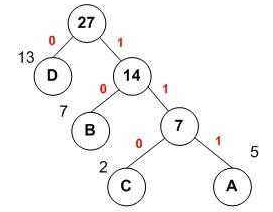哈夫曼编码的概念
哈夫曼编码是基于哈夫曼树实现的一种文件压缩方式。
哈夫曼树:一种带权路径最短的最优二叉树,每个叶子结点都有它的权值,离根节点越近,权值越小(根节点权值为0,往下随深度增加依次加一),树的带权路径等于各个叶子结点的数值与其权值的乘积和。哈夫曼树如图:

从图中我们可以看出,数据都存放在叶子结点中,且为了达到树的带权路径最短,我们把数值大的节点放在靠近根的位置,这棵树的带权路径长度为:23+53+72+131=48。接下来我们为每个节点赋予哈夫曼编码,假设从根节点出发,到左子树获得编码0,到右子树获得编码1,这样我们可以得到D的编码是0,B的编码是10,C的编码是110,A的编码是111。离根越近的节点对应的编码越短,节点的数值越大。那么,如何把哈夫曼编码应用在文档的压缩上呢?我们记文件中字符出现的次数为节点的数值,出现次数最多的字符会分配到哈夫曼树的靠近根节点的地方,自然也就会获得较短的哈夫曼编码。于是我们通过这种方式,使得文档中的字符获得不同的哈夫曼编码,因为出现频次高的字符对应编码较短,所以从文档中获取的字节被哈夫曼编码替换之后,会获使得其占用的总存储空间变小,实现压缩的效果。
实现哈夫曼压缩和解压的步骤详解
建立哈夫曼树:
1、使用IO流逐字节读取TXT文档。用一个数组(0~255,下标表示ASCII码)来保存不同字符出现的次数(对应位置加一)。
2、建一个节点类,保存节点对象的信息。将数组每一位表示的字符和出现频次存入创建的节点,把所有节点存入一个链表。
3、根据节点存储的频次值,对链表进行排序(从小到大)。
4、从链表中取出并删除最小的两个节点,创建一个他们的父节点,父节点不存字符,值为那两个节点的和,把那两个节点分别作为其左子节点和右子节点,最后把这个父节点存入链表。再次排序,取出并删除最小的两个节点,生成父节点,再存入…以此类推,最终生成一棵哈夫曼树。
5、对哈夫曼树进行遍历,使得叶子结点获得相应编码,同时把字符和它对应的哈夫曼编码存入HashMap。
哈夫曼压缩的实现:
1、再次读取原文档(之前第一次读取只是为了获取HashMap),根据HashMap中的字符与编码的键值对把整个文档转化为一串01码(此处可以用01字符串表示)。
2、准备将数据写入要压缩的目录。首先把HashMap写入(如果压缩文件中没有HashMap的信息,在解压的时候将无法还原)。HashMap包括两个部分,一部分是key值(即字符),占一个字节,另一部分是01字符串编码,若转为字节表示,可能小于8位有可能大于8位(即长度不确定),我们在写入时必须明确每个01串占据的字节个数,再者,因为我们是以字节的形式写数据,写数据的时候总位数应是8的整数倍,需要对01串末尾补0。我们具体是这样写HashMap的:写键值对的数量(占一个字节);写key值(把字符转为ASCII值写入,占一个字节);写01码占几个字节(是补0后的字节数,此信息占一个字节);写补0情况(某位补0数,此处也占一个字节),写补零后的01码对应的若干字节。继续下一个键值对的写入…以此类推,直到整个HashMap的键值对都写完。
3、刚才写的是编码信息,接下来准备把整个原文档转换得到的01串写入,这也是我们之后需要还原的信息。刚才的流没有关闭,我们是继续写入的。因为这依然会遇到最后一个字节不足8位的情况,我们需要补0并记录补0情况。先写整个文档的补0情况(一个字节),再把补0后的01串以每8位为一个字节写入压缩文件。
4、以上操作便实现了哈夫曼压缩。另外需要注意的是,IO流的read()和write()方法是对字节进行读写,如果写的是int类型的数据,那么它表示的是相应的ASCII码值,如果写入的是字符,也是会转化为对应的字节的(0~255个字符都有对应的ASCII码,也都有对应的字节表示)。
压缩格式如图:

解压的实现:
1、先读取第一个字节,即编码个数,确定了我们需要读多少组数据。
2、开始正式读取键值对信息。读取key值,读取01码对应的字节数,读取补0情况,再读取表示01串的字节数据,去掉之前补的0,还原回0和1表示的字符串,即字符对应的哈夫曼编码,把读到的字符和哈夫曼编码保存在一个新建的HashMap中,需要注意的是此处key值存储为哈夫曼编码,value值存储为字符的信息。以此类推,直到读完所有键值对信息。
3、读整个文件补0个数,读取文件字节数据,去掉补的0,得到之前存入的哈夫曼编码01字符串。
4、确定希望解压的文件目录。逐位读取01字符串,将读到的位累加在一个临时字符串中,每读一位都拿这个临时字符串和HashMap进行对照,如果有对应key值,则获取对应字符信息写入流,把字符串置空,继续循环累加新的01串。最终读完后,解压目录中便得到了我们解压后的文件。
代码实现
1、节点类:
public class Node<T> implements Comparable<Node<T>>{
private T data;
private int weight;
private Node<T> left;
private Node<T> right;
public Node(T data,int weight)
{
this.data=data;
this.weight=weight;
}
/**
* 获取节点数据
*/
public String toString()
{
return "data:"+data+" "+"weight:"+weight;
}
/**
* 节点权值比较方法
* @param o
* @return
*/
public int compareTo(Node<T> o) {
if(this.weight>o.weight)
return 1;
else if(this.weight<o.weight)
return -1;
return 0;
}
public void setData(T data)
{
this.data=data;
}
public void setWeight(int weight)
{
this.weight=weight;
}
public T getData()
{
return data;
}
public int getWeight()
{
return weight;
}
public void setLeft(Node<T> node)
{
this.left=node;
}
public void setRight(Node<T> node)
{
this.right=node;
}
public Node<T> getLeft()
{
return this.left;
}
public Node<T> getRight()
{
return this.right;
}
}
2、mian方法入口及建树的方法
public class HFMcompression {
public static void main(String[] args)
{
HFMcompression hc = new HFMcompression();
File file = new File("E:\\workspace\\mayifan\\src\\com\\myf\\HFMcompression1223\\data1.txt");//源文件地址
FileOperation fo = new FileOperation();
int [] a = fo.getArrays(file);
System.out.println(Arrays.toString(a)); //打印
LinkedList<Node<String>> list = hc.createNodeList(a);//把数组的元素转为节点并存入链表
for(int i=0;i<list.size();i++)
{
System.out.println(list.get(i).toString());
}
Node<String> root = hc.CreateHFMTree(list); //建树
System.out.println("打印整棵树、、、、");
hc.inOrder(root); //打印整棵树
System.out.println("获取叶子结点哈夫曼编码");
HashMap<String,String> map = hc.getAllCode(root);//获取字符编码HashMap
String str = fo.GetStr(map, file);
System.out.println("转化得到的01字符串:"+str);
File fileCompress = new File("E:\\workspace\\mayifan\\src\\com\\myf\\HFMcompression1223\\data2.zip");//压缩文件地址
fo.compressFile(fileCompress,map,str); //生成压缩文件
File fileUncompress = new File("E:\\workspace\\mayifan\\src\\com\\myf\\HFMcompression1223\\data3.txt");//压缩文件地址
fo.uncompressFile(fileCompress,fileUncompress);//解压文件至fileUncompress处
}
/**
* 把获得的数组转化为节点并存在链表中
* @param arrays
* @return
*/
public LinkedList<Node<String>> createNodeList(int[] arrays)
{
LinkedList<Node<String>> list = new LinkedList<>();
for(int i=0;i<arrays.length;i++)
{
if(arrays[i]!=0)
{
String ch = (char)i+"";
Node<String> node = new Node<String>(ch,arrays[i]); //构建节点并传入字符和权值
list.add(node); //添加节点
}
}
return list;
}
/**
* 对链表中的元素排序
* @param list
* @return
*/
public void sortList(LinkedList<Node<String>> list)
{
for(int i=list.size();i>1;i--)
{
for(int j=0; j<i-1;j++)
{
Node<String> node1 = list.get(j);
Node<String> node2 = list.get(j+1);
if(node1.getWeight()>node2.getWeight())
{
int temp ;
temp = node2.getWeight();
node2.setWeight(node1.getWeight());
node1.setWeight(temp);
String tempChar;
tempChar = node2.getData();
node2.setData(node1.getData());
node1.setData(tempChar);
Node<String> tempNode = new Node<String>(null, 0);
tempNode.setLeft(node2.getLeft());
tempNode.setRight(node2.getRight());
node2.setLeft(node1.getLeft());
node2.setRight(node1.getRight());
node1.setLeft(tempNode.getLeft());
node1.setRight(tempNode.getRight());
}
}
}
}
/**
* 建树的方法
* @param list
*/
public Node<String> CreateHFMTree(LinkedList<Node<String>> list)
{
while(list.size()>1)
{
sortList(list); //排序节点链表
Node<String> nodeLeft = list.removeFirst();
Node<String> nodeRight = list.removeFirst();
Node<String> nodeParent = new Node<String>( null ,nodeLeft.getWeight()+nodeRight.getWeight());
nodeParent.setLeft(nodeLeft);
nodeParent.setRight(nodeRight);
list.addFirst(nodeParent);
}
System.out.println("根节点的权重:"+list.get(0).getWeight());
return list.get(0);//返回根节点
}
public HashMap<String, String> getAllCode(Node<String> root)
{
HashMap<String, String> map = new HashMap<>();
inOrderGetCode("", map, root);
return map;
}
/**
* 查询指定字符的哈夫曼编码(中序遍历)
* @param code
* @param st
* @param root
* @return
*/
public void inOrderGetCode(String code ,HashMap<String, String> map,Node<String> root)
{
if(root!=null)
{
inOrderGetCode(code+"0",map,root.getLeft());
if(root.getLeft()==null&&root.getRight()==null)//存储叶子结点的哈夫曼编码
{
System.out.println(root.getData());
System.out.println(code);
map.put(root.getData(), code);
}
inOrderGetCode(code+"1",map,root.getRight());
}
}
/**
* 中序遍历输出整棵树
* @param root
* @return
*/
public void inOrder(Node<String> root)
{
if(root!=null)
{
inOrder(root.getLeft());
if(root.getData()!=null)
System.out.println(root.getData());
inOrder(root.getRight());
}
}
}
3、文件操作类(包括文件压缩对外的接口和文件解压对外的接口):
public class FileOperation {
FileOutputStream fos;//申明文件输出流对象
FileInputStream fis; //申明文件写入流对象
/**
* 通过文件获取数组的方法
* @param str
*/
public int[] getArrays(File file)
{
int[] arrays = new int[256];
try{
FileInputStream fis = new FileInputStream(file);
int ascii=0;
while((ascii=fis.read())!=-1)
{
arrays[ascii]++;
}
fis.close();
}catch(IOException e){
e.printStackTrace();
}
return arrays;
}
/**
* 读取文件获取01码
*/
public String GetStr(HashMap map,File file)
{
String str=""; //定义字符串储存01码
try{
FileInputStream fis = new FileInputStream(file);
int value=0;
while((value=fis.read())!=-1)
{
str+=map.get((char)value+""); //取单字符对应的01码,累加到字符串中
}
fis.close();
}catch(IOException e)
{
e.printStackTrace();
}
return str;
}
/**
* 写HashMap到文件(写入编码个数+第一个key+第一个value所占字节数+value最后一个字节的补0情况+第一个value的若干字节+下一个key+。。。。)
*/
public void writeHashMap(HashMap<String, String> map ,File file)
{
int size = map.size(); //获取编码的个数,即HashMap中的键值对个数
String temp=""; //存放临时8位01字符串
int value=0; //存放01字符串转化得到的ASCII值
try{
fos = new FileOutputStream(file);
fos.write(size); //写HashMap长度
Set<String> keySet = map.keySet(); //获取HashMap存放key的容器
java.util.Iterator<String> it = keySet.iterator();//通过容器获取迭代器
while(it.hasNext()) //迭代判断,有下一个key
{
String key = it.next(); //取出下一个key
String code = map.get(key); //取出code
fos.write(key.charAt(0)); //写key值
int a = code.length()/8;//能存满的字节数
int b = code.length()%8;//剩余的位数
int c =1; //值对应的存储的字节数
if(b==0) //无剩余位
{
c=a;
fos.write(c); //写code的字节数
fos.write(0); //写补0数,为0个
for(int i=0;i<a;i++) //写code值
{
temp="";
for(int j=0;j<8;j++)
{
temp+=code.charAt(i*8+j);
}
value=StringToInt(temp);
fos.write(value); //逐一把code的每一位写出去
}
}
else
{
c=a+1;
fos.write(c); //写code的字节数
fos.write(8-b); //写补0数
for(int i=0;i<8-b;i++) //补0
{
code+="0";
}
for(int i=0;i<c;i++)
{
temp="";
for(int j=0;j<8;j++)
{
temp+=code.charAt(8*i+j);
}
value=StringToInt(temp);
fos.write(value); //逐一写code,包括补的0
}
}
}
}catch(IOException e){
e.printStackTrace();
}
}
/**
* 把文档转化为的HFM编码写入文件
*/
public void writeHFMcode(String HFMcode)
{
int len = HFMcode.length(); //获取HFMcode长度
int a = len/8; //求出完整的字节的数目
int b = len%8; //求出剩余的位数
String temp = ""; //临时存放8位数据
int value = 0; //存放8位01转化得到的值
try
{
if(b==0) //无不足八位的部分,不需要补0
{
fos.write(0); //写补0数
for(int i=0;i<a;i++)
{
temp="";
for(int j=0;j<8;j++)
{
temp+=HFMcode.charAt(i*8+j);
}
value=StringToInt(temp);
fos.write(value); //写HFMcode
}
}
else //需要补0
{
int c = 8-b; //计算补0数
fos.write(c); //写补0数
for(int i=0;i<c;i++) //补0
{
HFMcode+="0";
}
for(int i=0;i<a+1;i++)
{
temp="";
for(int j=0;j<8;j++)
{
temp+=HFMcode.charAt(i*8+j);
}
value=StringToInt(temp);
fos.write(value); //写HFMcode
}
}
fos.close(); //写完关闭资源
}
catch(IOException e)
{
e.printStackTrace();
}
}
/**
* 把01字符串转化为ASCII码
* @param temp
* @return
*/
public int StringToInt(String temp)
{
int value=0;
for(int i=0;i<8;i++)
{
int x = temp.charAt(i)-48;
if(x==1) //为1则累加入value
{
value+=Math.pow(2,7-i); //表示2的(7-i)次方
}
}
return value;
}
/**
* 把数值转化为01字符串
* @param value
*/
public String IntToString(int value)
{
String temp1=""; //存放反的字符串
String temp=""; //存放正的字符串
while(value>0) //逐渐取出各个二进制位数,字符串为反向的
{
temp1+=value%2;
value=value/2;
}
for(int i=temp1.length()-1;i>=0;i--)
{
temp+=temp1.charAt(i);
}
return temp;
}
/**
* 把数值转化为01字符串,数值范围在0~255,01串不超过8位
* @param value
*/
public String IntToStringEight(int value)
{
String temp1=""; //存放反的字符串
String temp=""; //存放正的字符串
int add=0;
while(value>0) //逐渐取出各个二进制位数,字符串为反向的
{
add++;
temp1+=value%2;
value=value/2;
}
add=8-add;
for(int i=0;i<add;i++)//添0至8位
{
temp1+="0";
}
for(int i=temp1.length()-1;i>=0;i--) //反向的字符串获取正向的字符串
{
temp+=temp1.charAt(i);
}
return temp;
}
/**
* 对外部的接口,实现把压缩后的数据和信息写入压缩文件
* @param fileCompress
*/
public void compressFile(File fileCompress,HashMap<String, String> map,String HFMcode)
{
writeHashMap(map, fileCompress); //写HashMap的数据
writeHFMcode(HFMcode); //继续写HFMcode 01字符串
}
/**
* 解压获取HashMap
* @param fileCompress
*/
public HashMap<String, String> readHashMap(File fileCompress)
{
HashMap<String, String> mapGet = new HashMap<>();
try
{
fis=new FileInputStream(fileCompress);
int keyNumber = fis.read(); //读取key的数量
String key = ""; //HashMap的键值对
String code= ""; //未去0的字符串
String codeRZ="";//去0的字符串
int length=0; //表示还原后的字符串的理论长度,解决字符串前面的0的问题
int byteNum=1; //当前code占了几个字节
int addZero=0; //补0数
int value=0; //临时储值
int zeroLength=0;//code没有1的时候的字符串长度
for(int i=0;i<keyNumber;i++)
{
key = (char)fis.read()+""; //获取key值
byteNum=fis.read(); //获取code的字节数
addZero=fis.read(); //读取补0数量
if(addZero==0) //没有补0,是整字节数
{
for(int k=byteNum-1;k>=0;k--)
{
value+=fis.read()*(Math.pow(2, k*8));
}
code=IntToString(value);//把数值转为01code
value=0;//清零
length=8*byteNum-code.length();//计算在前面要补多少0
if(code.length()==0) //若code内数字都为0,只要去掉尾部即可
{
zeroLength=length-addZero; //计算有多少个0
for(int k=0;k<zeroLength;k++)
{
codeRZ+="0";
}
}
else //code值不为0,补充前面的0,去掉后面的0
{
for(int k=0;k<length;k++)
{
codeRZ+="0";
}
for(int k=0;k<code.length()-addZero;k++)
{
codeRZ+=code.charAt(k);
}
}
}
else //有补0
{
for(int k=byteNum-1;k>=0;k--)
{
value+=fis.read()*(Math.pow(2, k*8));
}
code=IntToString(value);//把数值转为01code
value=0;//清0
length=8*byteNum-code.length();//计算在前面要补多少0
if(code.length()==0) //若code内数字都为0,只要去掉尾部即可
{
zeroLength=length-addZero; //计算有多少个0
for(int k=0;k<zeroLength;k++)
{
codeRZ+="0";
}
}
else //code值不为0,补充前面的0,去掉后面的0
{
for(int k=0;k<length;k++)
{
codeRZ+="0";
}
for(int k=0;k<code.length()-addZero;k++) //不要后面的0
{
codeRZ+=code.charAt(k);
}
}
}
mapGet.put(codeRZ , key ); //把读取到的键值对存入创建的HashMap
codeRZ=""; //清空
}
}
catch(IOException e)
{
e.printStackTrace();
}
return mapGet;
}
/**
* 获取压缩文件中的数据,还原哈夫曼编码01串
*/
public String readHFMStr()
{
String str1=""; //存放获取到的直接的01字符串
String str=""; //存放去掉补0的字符串
int value=0;
String temp="";
try{
int addZero = fis.read(); //读取整个文件的补0个数
while((value=fis.read())!=-1)
{
temp=IntToStringEight(value); //把每个字节的数据转化为八位的01
str1+=temp;
}
if(addZero!=0) //有补0,获取补0前的字符串
{
for(int i=0;i<str1.length()-addZero;i++) //补0的部分不赋值
str+=str1.charAt(i)+"";
return str;
}
fis.close();
}
catch(IOException e)
{
e.printStackTrace();
}
return str1;
}
/**
* 写入文件的保存路径(写文件)
* @param str
* @param mapGet
* @param fileCompress
*/
public void writeFile(String str , HashMap<String, String> mapGet,File fileCompress)
{
try
{
fos = new FileOutputStream(fileCompress); //获取文件输出流
int len = str.length();//获取01串的长度
String temp=""; //临时存放段的01字符串
for(int i=0;i<len;i++)
{
temp+=str.charAt(i);
if(mapGet.containsKey(temp))
{
fos.write(mapGet.get(temp).charAt(0)); //一个字符的字符串转字符然后写出
temp="";
}
}
fos.close();
}
catch(IOException e)
{
e.printStackTrace();
}
}
/**
* 对外部的接口,实现解压文件,获取HashMap和文件内容
* @param fileCompress,压缩文件目录
* @param fileUncompress,解压到的目录
*/
public void uncompressFile(File fileCompress,File fileUncompress)
{
HashMap<String, String> mapGet = readHashMap(fileCompress); //获取哈希表
String str = readHFMStr(); //获取01字符串
writeFile(str,mapGet,fileUncompress); //写文件到保存路径
}
}
压缩、解压效果
1、压缩文件所占内存小于原文件,解压后的文件和原文件大小相同。如图data1是原文件,data2是压缩文件,data3的解压后的文件。我们可以发现压缩后的压缩包所占内存3KB<5KB。

2、原文件和解压后的文件的内容展示:
data1.txt:

data3.txt:

解压后txt的信息和原文件完全一致。